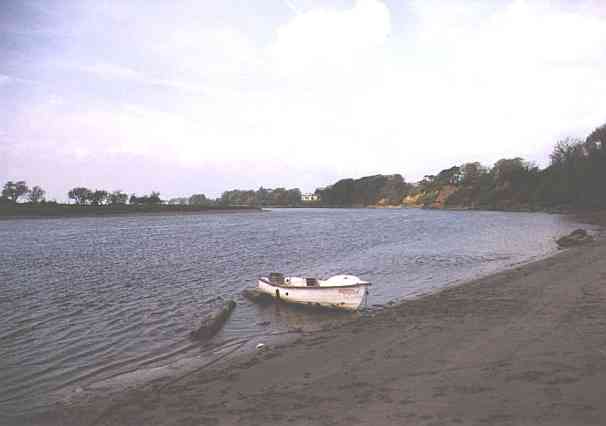0n entering England from the sister kingdom1, the first place we arrive at is Longtown, distant from Carlisle 10 miles. This is a small, neat, modern-built market-town; beautifully situated on the river Esk, in a very pleasant sporting country, and in the centre of the extensive estate of Sir James Graham; whose property it is, on the tenure of building-leases. The streets are regular and spacious; the buildings generally good. The number of inhabitants is computed at 1700, who have encreased about three-fourths within the last 30 years. The market is held on the Thursday: formerly it was supplied merely with butcher's meat and the produce of the dairy; but in the course of the last year a market for corn was established, which promises to add, in time, to the consequence of the place. It possesses a good inn, known by the sign of the Grahams' Arms. The manufactures are trifling.
About two miles distant from Longtown, on the left, is Netherby, the beautiful mansion of the worthy Baronet above-mentioned, commanding a fine view of the Esk and its adjacent fertile plains; being built on the site of a Roman station. Many curious pieces of antiquity have been here discovered, now in the possession of the owner. A little further is the village of Kirklinton, where Kirklinton-Hall, the mansion of Mrs. Dacre, is situated.
Along the Esk, and extending hence toward the sea, at a short distance, is an elevated morass, called Solway Moss, remarkable for an eruption in 1771. Owing, it is supposed, to continued rains having penetrated into and dissolved the substance of the moss, the shell or breast-work, formed of vegetable fibres, was gradually elevated. But succeeding dry weather evaporating part of the inclosed semi-fluid, thus removing its support, the rapid sinking of the shell forced out the embossomed mud, and was the cause of this inundation - an inundation, which overflowed the adjacent vale to a considerable depth, and by which no less than 18 towns* are said to have been destroyed, and the inhabitants forced to begin the world again! The plain thus covered was however shortly after completely cleared by the industry and perseverance of the late Dr. Graham, and is now as fertile as ever.2
Returning to the military road, we pass the neat vicarage-house and venerable church of Arthuret; in the burial-ground of which Archy, jester to Charles I. is said to be interred. Now crossing the river Line3, we pass through Westlinton, an insignificant village. In the appearance of the country, at this place, there is nothing remarkable or worthy of attention; but at Justice-Town, about two miles towards the west, THOMAS IRWIN, Esq. possesses an elegant mansion, around which he has made very considerable improvements.
 If the traveller incline or have the
opportunity, he may step aside to visit Rockcliff4.
Though not entitled to the highest merit of picturesque beauty, yet its situation is wild
and romantic; being immediately on the river Eden, whose rocky banks and shelvy precipices
give a dignity to the scene, - which the reflecting waves of the beautiful river, on which
are often seen skimming small vessels in the coasting trade, and a distant prospect of the
estuary of the Solway, afford a milder beauty, and form an agreeable contrast to the
insipidity of the surrounding country. There is nothing remarkable in the buildings,
excepting that of R. MOUNSEY, Esq. of Carlisle. It is a large and truly magnificent
edifice, newly built, commanding a fine view of the river and surrounding country. Mr.
DAVID CARRICK, banker in Carlisle, likewise possesses a very commodious and pleasant
house.
If the traveller incline or have the
opportunity, he may step aside to visit Rockcliff4.
Though not entitled to the highest merit of picturesque beauty, yet its situation is wild
and romantic; being immediately on the river Eden, whose rocky banks and shelvy precipices
give a dignity to the scene, - which the reflecting waves of the beautiful river, on which
are often seen skimming small vessels in the coasting trade, and a distant prospect of the
estuary of the Solway, afford a milder beauty, and form an agreeable contrast to the
insipidity of the surrounding country. There is nothing remarkable in the buildings,
excepting that of R. MOUNSEY, Esq. of Carlisle. It is a large and truly magnificent
edifice, newly built, commanding a fine view of the river and surrounding country. Mr.
DAVID CARRICK, banker in Carlisle, likewise possesses a very commodious and pleasant
house.
The tourist may now proceed directly to Carlisle, or retrace his step, to the military road, - without much prospect of being enchanted by the works of art, or the more prominent beauties of nature, until he reach the pleasant village of Stanwix.
Hence we have a fine view of the city of Carlisle, with its ancient cathedral (a striking object,) and noble castle, from whence a battery of guns, pointing toward the bridge, formerly seemed to menace the passenger's approach: they have been lately dismounted. The rich vale of Eden opens on each hand at our feet, shewing the sweeping course of the noble river through fertile and extensive holms. The river divides itself5 just below us, and each branch is spanned by an old ruinous, narrow, stone bridge, disgraceful to the county for having so long permitted it to remain in such a condition.6
Rickerby House, now the seat of JAMES GRAHAM,
Esq. adorned with beautiful gardens and ornamental buildings, is seen on the left, looking
down the verdant and spacious vale, with a fine view of Carlisle, which is beautifully
situated on a peninsula, between the Eden, the Caldew, and the Peterill.
* It is peculiar to this part of the country to give the term of town to even a single dwelling; as Johnstown, Jerriestown, &c. &c.
Jollie's Cumberland Guide & Directory 1811